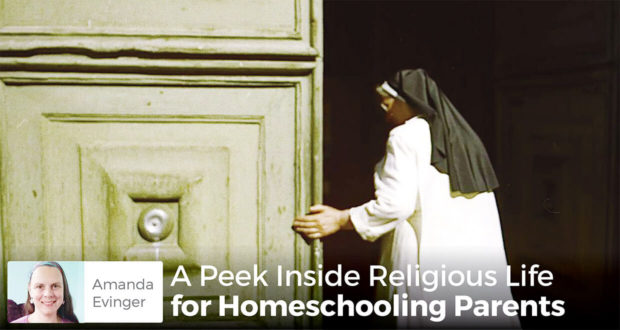Summary
Amanda Evinger shares insights and personal experience about religious life to help homeschooling parents encourage, not hinder, their children’s vocation.When parents think about sending their daughter to a convent, it may fill their stomach with butterflies or make their heart skip a few beats.
To a married lay mother or father, religious life may look beautiful, but ultimately, it is something foreign and perhaps frightening to them, something they have only seen from the outside looking in. They may have read strange or scary stories of religious life in Catholic books.
And, naturally, if their daughter enters the religious life, most parents will feel a great sense of sadness that they won’t get to share all of those wonderful family moments with her, such as watching her get married or holding her newborn baby.
From time to time, I am approached by well-meaning, loving parents with questions about religious life. I spent a short time as a postulant in a Carmelite cloister, about a year as a sister with the Contemplative Sisters of St. John, and nearly three years as a live-in volunteer for the Missionaries of Charity (Mother Teresa’s Sisters).
I also travelled to a number of other religious communities for short visits, such as the Visitation Sisters and the Colletine Poor Clares. I earned a Bachelor’s Degree in Theology as well, and took specialized courses in the history of religious life and medieval monasticism.
These experiences gave me an excellent overview of what being a religious sister is about, and I love to share my insights (and set anxious parents at peace)!
Here are some responses I have to common questions and concerns about the religious life:
1. Are they really that happy in there?
Yes, and yes, and sometimes, no! As is the general rule and understanding amongst religious communities, a religious who is not happy should not stay in religious life. Joy is the infallible sign of the presence of God in one’s life. Religious life carries numerous struggles, crosses, and sacrifices with it, but it also bears the mark of Heaven itself. It is a life that attempts to mirror the Beatific Vision — one which strives to offer free and beautiful worship to Almighty God day and night.
As Mother Mary Francis, P.C.C., writes in A Right to Be Merry,
“The nun who goes back to her cell after Matins may be tired, but she is the happiest person in the world. From entering the choir and prostrating before the Blessed Sacrament, through raising a dry-throated song to God and then begging Him in a solemn prayer to ‘Open her mouth to bless His holy Name,’ right down to the last ‘Amen’, she has been busy at the only really important thing a human being has to do….We rise and kneel and chant to worship Him. For this, all of us were born, and nothing else.”
As with any vocation, there will certainly be challenges. The religious life is a life of self-sacrifice. A novice may be asked to be work alongside a certain sister whom she dislikes; a long-time religious may be asked to become the Superior of a community when she is intimidated to do so; a missionary sister may be moved to 20 different locations over the course of her religious life.
Yet, as a Missionary of Charity sister once told me, they are “in love” with their vocation, as a husband and wife are in love, and can’t imagine living without it, just as a married woman can’t imagine leaving her family.
2. What do they do all day?
Depending on the type of religious order, their days are filled with various levels of prayer and activity. Cloistered contemplative or fully contemplative orders dedicate their entire lives to the work of prayer.
A typical day would likely involve at least four communal recitations of the Divine Office said in common (cloistered communities generally pray all seven).
Contemplative-active communities (such as the Contemplative Missionaries of Charity) spend a majority of their time in prayer, while a couple of hours are devoted each day to apostolic work, such as visiting the poor.
Active communities spend a good amount of their day at the apostolate, while several hours are still reserved for prayer.
In addition to prayer and work, most communities have daily times for recreation, which can be anything from taking a walk together, to making scapulars while telling funny stories, or having personal recreation time for reading or art work.
Ultimately, a religious aspires to direct each and every act to the glory of God on high — and they do it so wonderfully! I will never forget how absolutely gorgeous were the sounds of the cloistered Carmelites as they processed to chapel, chanting the verses of the Psalm,
“Let the people praise you, O God, let all the peoples praise You.”
Mother Mary Francis writes,
“Hidden away from the glare and noise of worldly living, we are enclosed in the womb of holy Church. I walk down the cloisters, and my heart moves to a single tune: Lord, it is good, so good to be here!”
3. Can they leave easily if they want to?
Definitely! When a person enters a religious community, it is always on a trial basis.
As a priest once told me, “You look at them, and they look at you” for a few years, and then you decide what God wants together. Superiors have a real knack for helping a young person discern if the community is the right fit for her, and if it is not, they are usually very good about saying so charitably, and even helping her find her next move in life.
Personally, I had a superior who saw that religious life was not for me, and she encouraged me to take a month away from the community and spend it with a family.
After much, much prayer and spiritual direction from additional sources, in the end, she not only helped me discern it was God’s will for me to get married, but she actually helped me to meet my future spouse (one of my fellow novice’s brothers!)
4. Are they really using their talents?
For many parents who have made tremendous sacrifices to homeschool their children well and make sure they know the ins-and-outs of Calculus, how to write a stellar essay, and get top-notch scores on college entrance exams, their child’s decision to enter the religious life can seem like a test of faith.
If they are just praying all day, how are they going to use all we’ve worked so hard to teach them?
A parent may wonder. In the convent, I saw many sisters with plenty of higher education, and loads of talents of all kinds. A sister who was once a lawyer may be called upon to handle the paperwork behind constructing a multi-million-dollar monastery; another sister who was the oldest of 12 children may be asked to be a Novice Mistress.
My sister-in-law is a very talented artist, and she makes religious articles for the use of her community as well as to be sold in the bookstore. When a woman whole-heartedly follows the vocation to which God has called her, she will inevitably use her talents to the full, much fuller than if she denied her true calling in life.
As homeschooling parents, we should pray for the grace to be generous with our sons and daughters, and open to whatever vocation God has in mind for them. We should continually ask for enlightenment on how to homeschool them the best we can, preparing them for all God has in store for them.
St. Elizabeth Ann Seton, ora pro nobis!
Header photo CC Nikola Balic | flickr.com

 Seton Magazine Catholic Homeschool Articles, Advice & Resources
Seton Magazine Catholic Homeschool Articles, Advice & Resources

